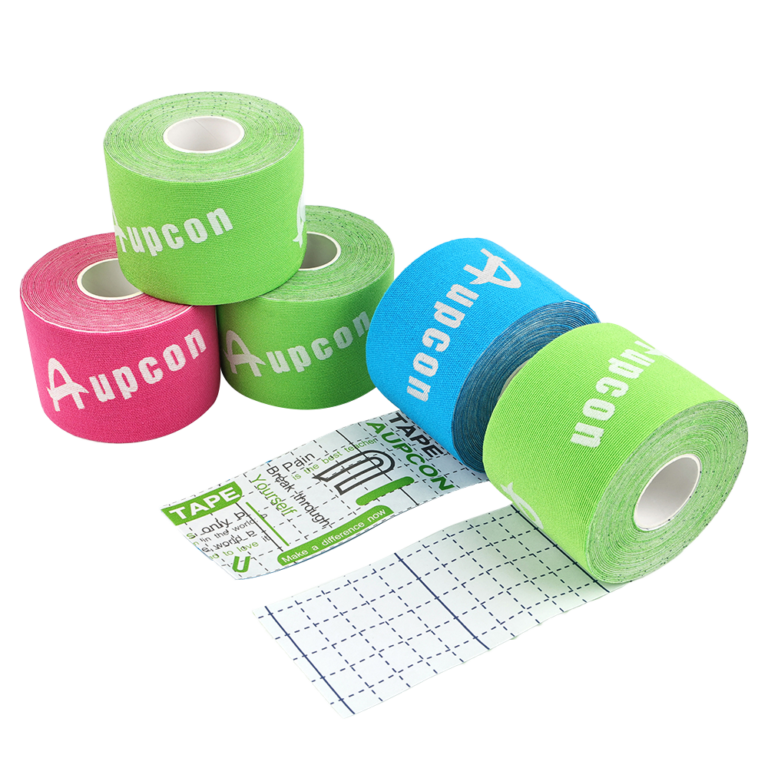Some graphic descriptions of rigid sports tape methods:
Lateral neck muscles:
Behind the ear, the muscles that connect the jaw and the clavicle keep the head stable at rest. The jaw is raised, the head is turned left and right, etc.
Injury example: When the blood vessels under this muscle are compressed, it is easy to cause dizziness and tinnitus.
Sitting position: The Y-shaped rigid sports tape is fixed on the protrusion behind the ear.
When sticking, tilt the head slightly in the opposite direction, straighten the head and neck, and stick the outer tape to 1/3 of the clavicle.
Trapezius: Muscles that start in the neck and extend to the shoulders and back. The neck is the upper part, the shoulder is the middle part, and the back is the lower part (the stabilizer of the scapula). Lift your shoulders up and stretch back.
Injury example: This part of the muscle hurts during excessive throwing movements such as baseball and throwing.
Seated position: Fix the base of the Y-shaped rigid sports tape on the shoulder (the junction of the clavicle and the scapula). Turn your face to the opposite side, lift your chin, and apply one end of the rigid sports tape to the spot along the shoulder line.

Bend the elbows to the chest, stretch the muscles to the other segment, and apply the rigid sports tape diagonally down the spine.
supraspinatus: Muscle from the scapula to the humerus (where it is not easy to tell by appearance). The muscles that suspend the humerus over the shoulder rotate the upper shoulder outward.
Injury example: It hurts when the arm is raised. Throwing baseball, swinging tennis racket, etc., pain when the upper arm rotates out. tendonitis, etc.
With your arms down naturally, place the bottom end of the rigid sports tape above your shoulder blades and stick it down along the shoulder line.
The other point is slightly behind the shoulders, and the ends are overlapped together.
Injury example: Tenosynovitis of the wrist is an injury caused by movement of the wrist joint. For example, there are many players such as baseball, tennis, golf, billiards, and badminton.
erector spinae: Muscles on both sides of the back spine that manage the movement of the spine (extension, lateral flexion), and fix the spine.
Examples of injuries: the back, neck, waist and other related parts. There are many injuries caused by tension in the lower back (American football, rugby interception, sumo wrestling and other fighting skills).
sit on the chair. The base of the rigid sports tape is fixed on the lumbosacrum (inverse triangular bone between the left and right pelvis)
Paste it on the other side as well.
Quads: The extension point of the knee is very large, which is the most important for athletes.
Injury example: Track and field, football, volleyball, basketball, skiing and other sports with a considerable burden on the legs, this muscle is the most injured. The knee joint is also prone to injury when the muscles are weak.
Lie on your back with your feet relaxed and straight. The base of the long rigid sports tape (cut enough to cover the knee) is fixed on the upper outer thigh. Bend the knee and stick it well, and wrap the part of the Y-shaped part along the side of the knee bone.
Lay the same way on the opposite side, overlapping the ends under the knee bone.
Soleus: The upper posterior part of the calf, shaped like a soleus, the lower end of the soleus and the gastrocnemius form the Achilles tendon.
Injury example: It is a project where the heel is strongly impacted, such as jumping and landing, emergency stop of basketball, various strenuous sports, etc.
Lie on your stomach with your knees bent and secure the base of the rigid sports tape to your heels.
One end of the rigid sports tape is attached along the inside of the calf to under the knee, and the Achilles tendon must be stretched.
Attach the other end to the outside of the calf in the same way.
Muscle stickers recommended by good things
Muscles are used by many athletes in many sports. Correct use of muscle stickers has many effects on the human body, such as relieving muscle pain after exercise, effectively protecting body muscles, and reducing fatigue and strain.
Muscle stickers play a big role in our usual sports, or in the recovery process of the injured part after an injury.
Of course, the rigid sports tape is not a drug, it is only an auxiliary product, and it should not be too dependent. In amateur competitions and peacetime confrontations and training, the protection of key parts cannot be ignored.
For vulnerable friends, muscle stickers are affordable and practical. Compared with the knee pads and other protective gear that are used repeatedly, the rigid sports tape is obviously more practical and hygienic than the single-purpose protective gear.
Of course, we should also understand its correct usage from various channels, and if it is used incorrectly, it will also do us some harm.



